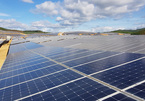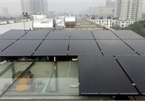 |
| Vaibhav Saxena, lawyer at Vietnam International Law Firm, discusses the new solar energy FiT |
The new decision will fill the gaps of Decision No.11/2017/QD-TTg dated April 2017 as amended by Decision No.02/2019/QD-TTg dated January 2019. Overall, Decision 13 draws a clear distinction between grid-connected solar power projects and rooftop solar power ones, each enjoying different regimes and feed-in tariffs (FiT).
Overall, the classification of such power schemes under Decision 13 remains the same as Decision 11 whereby solar ones are divided into grid-connected solar power schemes, and rooftop power ones.
However, Decision 13 has provided better clarity by further classifying grid-connected power projects into two types – those of floating solar power and ground solar power. Floating power projects are a new entrant in Vietnam’s solar sector and it is defined as the grid-connected solar venture with photovoltaic panels installed on a floating structure on the water surface. Other grid-connected solar power projects which are not floating power in type will be taken as ground solar power projects.
Although both floating solar power and ground power ventures are grid-connected, they would enjoy a different FiT rate under Decision 13.
In that, Electricity of Vietnam (EVN) or its member units are no longer the sole power purchasers as other parties, organisations, and individuals have also been included in the definition of “electricity purchaser”. This undoubtedly paves the way for the upcoming direct power purchase agreement (DPPA) regime as proposed by the Ministry of Industry and Trade (MoIT) under Proposal No.544/TTr-BCT dated January 2020.
The model PPA, which is issued by the MoIT, will be compulsory for both grid-connected and rooftop solar power projects that involve EVN or its authorised member units as the power purchaser. As such, in the event the purchaser of a rooftop solar power scheme is any party other than EVN or its authorised member units, the parties may freely negotiate on the contents of the PPA in accordance with the relevant laws.
Similar to Decision 11, the term of the model PPA will be 20 years from the commercial operation date (COD) for grid-connected solar power projects. With regards to a rooftop project whose power purchaser is EVN or its authorised member units, the term of the model PPA shall not exceed 20 years from the power generation date.
It appears that while the term of the model PPA in a grid-connected solar power project is fixed at 20 years, such term of the model PPA in a rooftop equivalent could be shorter as long as it does not exceed 20 years. In any case, this term may be extended or renewed in accordance with the laws at the time of such extension or renewal.
Grid-connected solar schemes
Under Decision 13, electricity purchasers, EVN, its member units, or other parties are required to purchase all electricity produced by the project connected to the national grid system. This may be deemed a move to lower the risks of curtailment for the electricity producers, thereby encouraging investors to participate in the solar energy market.
However, Decision 13 to an extent limits the electricity purchase obligation of purchasers to only “all electricity produced for the national grid”, whereas the previous Decision 11 requires purchasers to purchase “all electricity produced from solar power projects”.
As noted above, new to Decision No. 13 is the inclusion of floating solar systems and ground power schemes in the definition of grid-connected solar power projects. Floating power systems, although still required to comply with requirements applicable to all grid-connected power projects, enjoy a more favourable FiT.
If the purchaser is EVN or its member units, the applicable FiT will be VND 1,644 per kilowatt hour (equivalent to 7.09 US cents per kWh) for ground projects and VND 1,783/kWh (equivalent to 7.69 US cents per kWh) for floating solar schemes, excluding VAT.
The exchange rate is in accordance with the central exchange rate of VND/USD as announced by the State Bank of Vietnam (SBV) on 10 March 2020. This FiT will be adjusted in accordance with any fluctuations of the applicable VND/USD exchange rate, which is the central exchange rate announced by the SBV on the date of the issuance of invoices.
In order to enjoy this FiT, solar power projects must (i) have obtained an in-principle investment approval from competent authorities before 23 November 2019, (ii) have COD between 1 July 2019 and 31 December 2020, and (iii) has a solar cell capacity of more than 16 per cent or a solar module of more than 15 per cent.
In line with Resolution No.115/NQ-CP dated August 2018 on the application of special mechanisms and policies for the socio-economic development of Ninh Thuan province, solar projects in this province may enjoy a more favourable FiT of VND 2,086/kWh, equivalent to 9.35 US cents per kWh. This FiT will be adjusted in accordance with any fluctuations of the applicable VND/USD exchange rate.
Such favourable FiT applies to projects in Ninh Thuan Province that (i) have been included in the regional power development master plan, (ii) have COD before 1 January 2021, (iii) have the total accumulated capacity not exceeding 2,000MW; and (iv) have solar cell capacity of more than 16 per cent or solar module of more than 15 per cent.
For ventures not falling into any of the aforementioned categories, the electricity price will be determined by competitive power market mechanisms. This falls in line with the competitive bidding and auction mechanism currently under development, opening up the solar energy market to a more competitive approach.
The power producer or the seller is required to invest, install, operate and maintain power metering equipment, transmission lines and booster substations (if any), from the power plant of the producer to the connection point of the national grid. The connection point is agreed between the seller/producer and the purchaser in accordance with the approved relevant power development master plan.
Further, the seller is responsible for the loss of power on the transmission line and the loss from a booster substation of the power plant if the connection point is different from the point of the installed metering equipment. Therefore, it is imperative that the sellers make sure the connection point is the same as the metering equipment point.
Rooftop solar power schemes
Rooftop solar power systems under Decision 13 are defined as those with photovoltaic panels installed on the roof of a construction and having a capacity of not exceeding one 1MW, directly or indirectly connected to the grid with a voltage of 35 kV or less of the electricity purchaser. The 1MW capacity threshold, although absent in the previous Decision 11, falls in line with Circular No.16/2017/TT-BCT dated September 2017 regulating project development and model PPA applied to solar power projects.
Accordingly, rooftop solar power schemes with capacity exceeding this threshold will be subject to master planning related procedures, which is similar to other grid-connected power projects.
Under Decision 13, the investors of rooftop solar power ventures could sell the power generated by their rooftop power system to (i) EVN or its members by entering into a model PPA, or (ii) other individuals or organisations by entering into a private PPA. As the private PPA would be negotiated between the parties, the provisions of Decision 13 as discussed below apply to the rooftop solar power project having the purchaser as EVN or its authorised members.
The applicable FiT will be VND 1,943/kWh (equivalent to 8.38 US cents per kWh). This will be adjusted in accordance with any fluctuations of the applicable exchange rate, which is the central VND/USD rate announced by the SBV on the last day of the previous year to calculate the electricity bill paid for the following year.
This FiT is only applicable to initiatives that (i) are put into operation and have the meter data confirmed between 1 July 2019 and 31 December 2020, and (ii) have solar cell capacity of more than 16 per cent or solar module of more than 15 per cent. It appears that rooftop projects which do not meet these requirements will have to find solutions with a Private PPA or wait for the DPPA programme to pitch in.
Decision 13 also provides the payment mechanism where the payment invoice is made on the basis of electricity output and input separately. The decision stands flexible with the wordings in relation to the use of the bi-directional meter and the provision on the payment for rooftop solar power projects seems to inherit the core mechanism whereby the power sellers would separately pay for the electricity input for their use, while also get paid for the electricity output generated and transmitted to the national grid of EVN.
In order to connect to the national grid directly or indirectly, rooftop power projects must register for connection with EVN or its authorised member units. This provision would facilitate the investors in terms of better security for connecting their rooftop solar power projects, while simultaneously ensuring that the national grid is not congested or overloaded. Also, EVN would be responsible to invest, install, and maintain the electricity meter.
Roles of relevant authorities
The MoIT is responsible to co-ordinate with the People’s Committee of Ninh Thuan province and EVN to inspect the solar power projects qualified for the favourable FIT under Decision 13 and Resolution 115.
Furthermore, the MoIT is given the charge to issue the standard form PPA, the electricity output metering regime for rooftop solar power systems involving parties other than EVN and its member units, and research and finalise the bidding mechanism for power projects.
The People’s Committees is responsible to co-ordinate and assist investors in land clearance, compensation, facility, and workforce for the investment of solar power projects in their regions.
EVN, meanwhile, is responsible to account for the costs of purchasing electricity from solar projects that have entered into a PPA with EVN or an authorised member, and including them in the input parameters of the annual plan of electricity wholesale and retail price of EVN.
Additionally, EVN is responsible for the investment of energy reserve solutions for the system in order to ensure the stable operation of the power system on the integration of renewable energy sources, as well as the development of information management system of grid-connected and rooftop power development nationwide. EVN is also responsible to review progress of grid projects to ensure capacity release of grid-connected solar ventures and rooftop power systems, not causing overload of the national electricity system.
In accordance with Decision No.13/2020/QD-TTg dated April 6, 2020
|
No. |
Solar power technology |
FiT |
|
|
VND/kWh |
Equivalent to US cent/kWh |
||
|
1 |
Floating solar power system |
1,783 |
7.69 |
|
2 |
Ground solar power project |
1,644 |
7.09 |
|
3 |
Grid-connected solar power project in Ninh Thuan province |
2,086 |
9.35 |
|
4 |
Rooftop solar power project |
1,943 |
8.38 |
Streamlining the roles of the key stakeholders will help to synchronise the power master planning at a national level and minimise the risk for curtailment in terms of production and offtake of the power generated by the solar power projects in Vietnam. VIR

Wind, solar power projects in Vietnam stall during pandemic period
Instead of rushing to build wind and solar power plants as seen a year ago, investors now have no other choice but to wait.

Roof-top solar power offers saving solution during COVID-19 pandemic
Despite the impact of the COVID-19 pandemic and many countries limiting customs clearance, solar power enterprises with manufacturing plants in Vietnam are still taking advantage of the domestic market to serve customers and sustain growth.
 Vaibhav Saxena, foreign lawyer at Vietnam International Law Firm, discusses how Decision No.13/2020/QD-TTg will impact the Vietnamese solar power market.
Vaibhav Saxena, foreign lawyer at Vietnam International Law Firm, discusses how Decision No.13/2020/QD-TTg will impact the Vietnamese solar power market.